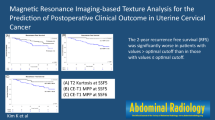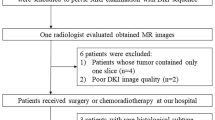Abstract
Introduction
To determine the performance of texture analysis and conventional MRI parameters in predicting tumoral response to neoadjuvant chemotherapy and to assess whether a relationship exists between texture tissue heterogeneity and histological type of uterine cervix cancer.
Method and materials
Twenty-eight patients with local advanced cervical cancer (FIGO IB2-IIIB), underwent MRI before chemotherapy. Texture analysis parameters were quantified on T2-weighted sequences, as well as the maximum diameter expressed in mm. ADC values were obtained on the ADC map. Statistical analysis included unpaired t test and ROC curve.
Results
No statistical correlation was found between conventional parameters and response to NACT. Mean and skewness showed a strong correlation with the histological type: Adenocarcinomas presented higher mean and skewness values (69.8 ± 10.5 and 0.55 ± 0.19) in comparison with squamous cell carcinomas. Using a cutoff value ≥ 29 for mean it was possible to differentiate the two histological types with a sensitivity of 100% and a specificity of 81%. Kurtosis showed a positive correlation with tumor response to NACT resulting higher in responders (v.m. 5.7 ± 1.1) in comparison with non-responders (2.3 ± 0.5). The optimal Kurtosis cutoff value for the identification of non-responders tumors was ≤ 3.7 with a sensitivity of 92% and a specificity of 75%.
Conclusion
Texture analysis applied to T2-weighted images of uterine cervical cancer exceeded the role of conventional prognostic factors in predicting tumoral response; moreover, they showed a potential role to differentiate histological tumor types.






Similar content being viewed by others
Abbreviations
- NACT:
-
Neoadjuvant chemotherapy
- LACC:
-
Local advanced cervical cancer
- FIGO:
-
International Federation of Gynecology and Obstetrics
- MR:
-
Magnetic Resonance
- TA:
-
Texture analysis
- ROC:
-
Receiver operating characteristic
- AUC:
-
Area under the curve
References
Bhatla N, Aoki D, Sharma DN et al (2018) Cancer of the cervix uteri. Int J Gynaecol Obstet 143:22–36
Pecorelli S (2009) Revised FIGO staging for carcioma of the vulva, cervix, and endometrium. Int J Gynaecol Obstet 105(2):103–104
Pecorelli S, Zigliani L, Odicino F (2009) Revised FIGO staging for carcinoma of the cervix. Int J Gynaecol Obstet 105(2):107–108
Sala E, Rockall AG, Freeman SJ (2013) The added role of MR imaging in treatment stratification of patients with gynecologic malignancies: what the radiologist needs to know. Radiology 266:717
Subak LL, Hricak H, Powell CB et al (1995) Cervical carcinoma: computed tomography and magnetic resonance imaging for preoperative staging. Obstet Gynecol 86(1):43–50
Wang JZ, Mayr NA, Zhang D et al (2010) Sequential magnetic resonance imaging of cervical cancer: the predictive value of absolute tumor volume and regression ratio measured before, during, and after radiation therapy. Cancer 116:5093–5101
Nelson DA, Tan TT, Rabson AB et al (2004) Hypoxia and defective apoptosis drive genomicin stability and tumourigenesis. Genes Dev 18:2095–2107
Davnall F, Yip CS, Ljungqvist G et al (2012) Assessment of tumor heterogeneity: an emerging imaging tool for clinical practice? Insights Imaging 3:573–589
Ganeshan B, Miles KA (2013) Quantifying tumour heterogeneity with CT. Cancer Imaging 13:140–149
Nakamura K, Joja I, Kodama J et al (2012) Measurement of SUVmax plus ADCmin of the primary tumour is a predictor of prognosis in patients with cervical cancer. Eur J Nucl Med Mol Imaging 39:283–290
Chen J, Zhang Y, Liang B (2010) The utility of diffusion-weighted MR imaging in cervical cancer. Eur J Radiol 74(3):101–106
Gerlinger M, Rowan AJ, Horswell S et al (2012) Intratumor heterogeneity and branched evolution revealed by multiregion sequencing. N Engl J Med 367(10):976
Kassner A, Thornhill RE (2010) Texture analysis: a review of neurologic MR imaging applications. AJNR Am J Neuroradiol 31:809–816
Skogen K, Ganeshan B, Good C et al (2013) Measurements of heterogeneity ing liomas on computed tomography relationship to tumour grade. J Neurooncol 111:213–219
Ganeshan B, Abaleke S, Young RC et al (2013) Texture analysis of non-small cell lung cancer on unenhanced computed tomography: initial evidence for a relationship with tumour glucose metabolism and stage. Cancer Imaging 10:137–143
Ganeshan B, Goh V, Mandeville HC et al (2013) Non-small cell lung cancer: histopathologic correlates for texture parameters at CT. Radiology 266:326–336
Ganeshan B, Panayiotou E, Burnand K et al (2012) Tumour heterogeneity in non-small cell lung carcinoma assessed by CT texture analysis: a potential marker of survival. Eur Radiol 22:796–802
Win T, Miles KA, Janes SM et al (2013) Tumor heterogeneity and permeability as measured on the CT component of PET/CT predict survival in patients with non-small cell lung cancer. Clin Cancer Res 19:3591–3599
Goh V, Ganeshan B, Nathan P et al (2011) Assessment of response to tyrosine kinase inhibitors in metastatic renal cell cancer: CT texture as a predictive biomarker. Radiology 261:165–171
Ganeshan B, Burnand K, Young R et al (2011) Dynamic contrast-enhanced texture analysis of the liver: initial assessment in colorectal cancer. Invest Radiol 46:160–168
Ng F, Ganeshan B, Kozarski R et al (2011) Assessment of primary colorectalc ancer heterogeneity by using whole-tumor texture analysis: contrast-enhanced CT texture as a biomarker of 5-year survival. Radiology 266:177–184
Ahmed A, Gibbs P, Pickles M et al (2013) Texture analysis in assessment and prediction of chemotherapy response in breast cancer. J Magn Reson Imaging 38:89–101
De Cecco CN, Ganeshan B, Ciolina M et al (2015) Texture analysis as imaging biomarker of tumoral response to neoadjuvant chemoradiotherapy in rectal cancer patients studied with 3-T magnetic resonance. Invest Radiol 50(4):239–245
Torheim T, Malinen E, Kvaal K et al (2014) Classification of dynamic contrast enhanced MR images of cervical cancers using texture analysis and support vector machines. IEEE Trans Med Imaging 33(8):1648–1656
Panici PB, Di Donato V, Palaia I et al (2016) Type B versus Type C radical hysterectomy after neoadjuvant chemotherapy in locally advanced Cervical carcinoma: a propensity-matched analysis. Ann Surg Oncol 23(7):2176–2182
Nakamura K, Joja I, Nagasaka T et al (2012) The mean apparent diffusion coefficient value (ADCmean) on primary cervical cancer is a predictive marker for disease recurrence. Gynecol Oncol 127(478–83):7
Erbay G, Onal C, Karadeli E et al (2017) Predicting tumor recurrence in patients with cervical carcinoma treated with definitive chemoradiotherapy: value of quantitative histogram analysis on diffusion-weighted MR images. Acta Radiol 58:481–488
Somoye G, Harry V, Semple S et al (2012) Early diffusion weighted magnetic resonance imaging can predict survival in women with locally advanced cancer of the cervix treated with combined chemo-radiation. Eur Radiol 22(2319–27):9
Katanyoo K, Sanguanrungsirikul S, Manusirivithaya S (2012) Comparison of treatment outcomes between squamous cell carcinoma and adenocarcinoma in locally advanced cervical cancer. Gynecol Oncol 125:292–296
Galic V, Herzog TJ, Lewin SN et al (2012) Prognostic significance of adenocarcinoma histology in women with cervical cancer. Gynecol Oncol 125:287–291
Hopkins MP, Morley GW (1991) A comparison of adenocarcinoma and squamous cell carcinoma of the cervix. Obstet Gynecol 77:912–917
Chung CK, Stryker JA, Ward SP et al (1981) Histologic grade and prognosis of carcinoma of the cervix. Obstet Gynecol 57:636–642
Parikh J, Selmi M, Charles-Edwards G et al (2014) Changes in primary breast cancer heterogeneity may augment midtreatment MR imaging assessment of response to neoadjuvant chemotherapy. Radiology 272:100–112
Author information
Authors and Affiliations
Corresponding author
Ethics declarations
Conflict of interest
The authors declare that they have no conflict of interest.
Ethical standards
All procedures performed in studies involving human participants were in accordance with the ethical standards of the institutional and/or national research committee and with the 1964 Helsinki Declaration and its later amendments or comparable ethical standards.
Informed consent
Informed consent was obtained from all individual participants included in the study.
Additional information
Publisher's Note
Springer Nature remains neutral with regard to jurisdictional claims in published maps and institutional affiliations.
Rights and permissions
About this article
Cite this article
Ciolina, M., Vinci, V., Villani, L. et al. Texture analysis versus conventional MRI prognostic factors in predicting tumor response to neoadjuvant chemotherapy in patients with locally advanced cancer of the uterine cervix. Radiol med 124, 955–964 (2019). https://doi.org/10.1007/s11547-019-01055-3
Received:
Accepted:
Published:
Issue Date:
DOI: https://doi.org/10.1007/s11547-019-01055-3




